Step 1: Anticipation
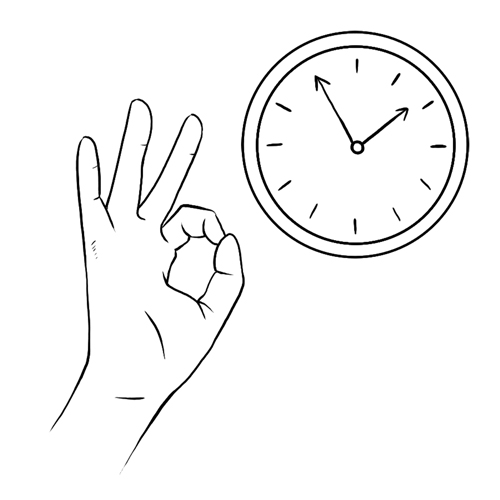
|
See the full description here
Summary:
Collaborate and form a team with your child. When you invest the time to form a strong team, children feel more comfortable and less anxious – this will help you complete the care with less stress – for you and your child.
Use these tips, from the start, to set the stage for a positive care procedure:
- Create the right moment: integrate the care in a routine.
- Alert your child to the needed care and communicate together.
- Form a team with your child: Encourage autonomy by offering realistic choices such as the method of distraction. Stay tuned to your child. Manage pain and anxiety, using distraction and positioning for comfort.
|
|
Step 2: Preparation
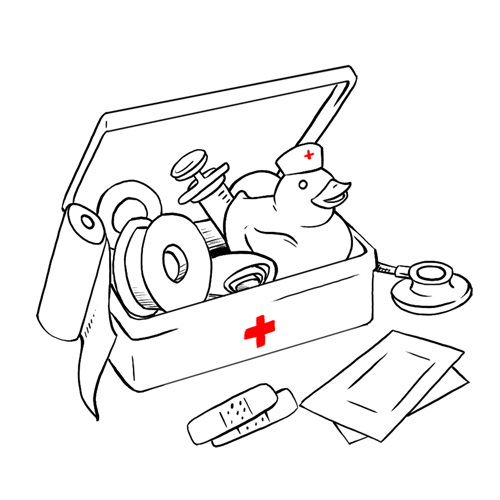
|
See the full description here
Summary:
- Prepare the environment: Identify a routine place for care. Close windows, doors and fans. Wash and dry the work surface and gather the needed materials for the care and to distract your child.
- Prepare your child: Get help if needed. Position your child for comfort to receive the care and start to use the selected distraction method.
- Prepare yourself: Find the right time when you are ready to provide the care safely. Review the list of care steps. Wash your hands.
Now that you are ready to start the care procedure, take the opportunity to encourage and praise your child.
|
|
Step 3: Procedure

|
See the full description here
Summary 3 key concepts:
- Safety: Carefully follow the care practice steps as you have been taught.
- Flexibility: Be ready to adjust according to your child’s reactions during the procedure. As needed, reposition or select an alternative distraction strategy. Follow your child’s pace and rhythm.
- Collaboration: Reassure your child, verbally and non-verbally. Acknowledge your child’s emotions and reactions. Help your child differentiate between the different sensations during a procedure.
|
|
Step 4: Prepare the materials
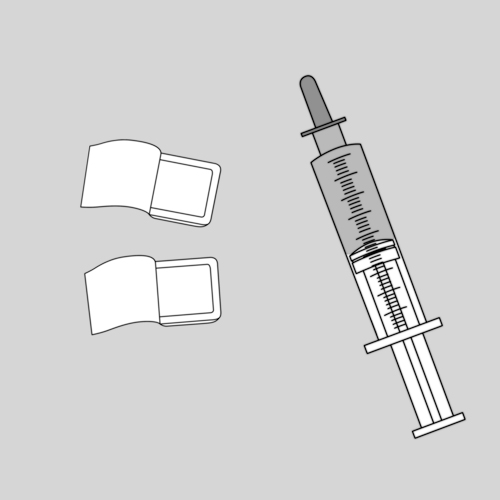
|
- Select and clean a workspace surface (eg, tabletop).
- Gather the necessary equipment.
- Check that the saline syringe is at room temperature.
Why ? This step ensures safety and allows the subsequent procedure.
|
|
Step 5: Remove the air bubbles from the saline syringe

|
- Hold the syringe vertically with the protective cap facing up.
- Push the plunger of the syringe to release it.
- Strike the syringe vigorously with your thumb and forefinger to raise the air bubbles.
- Partially unscrew the protective cap.
- Gently push the plunger until there is no more air in the syringe and a drop of liquid appears at the junction of the protective cap and the end of the syringe.
- Screw the protective cap back onto the syringe tip.
- Place the syringe on your table.
If necessary, refer to the technique taught by your healthcare team, pharmacy or manufacturer’s recommendations.
Why ? This step is necessary for the security of the administration of the solution.
|
|
Step 6: Position your child
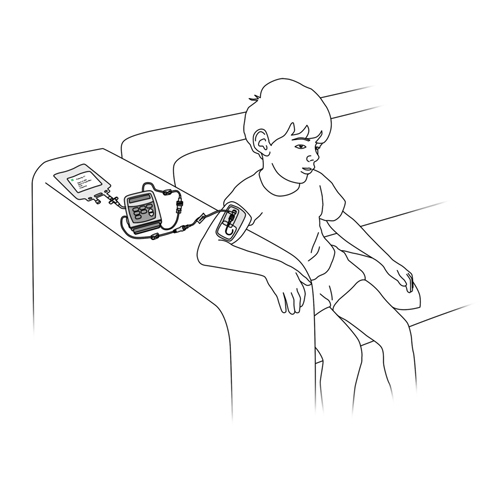
|
Position your child:
- to securely reach the catheter entry site,
- in one of the positions discussed with your healthcare team,
- depending on comfort, age and ability to collaborate.
Why ? This step facilitates the work.
|
|
Step 7: Monitor the catheter site
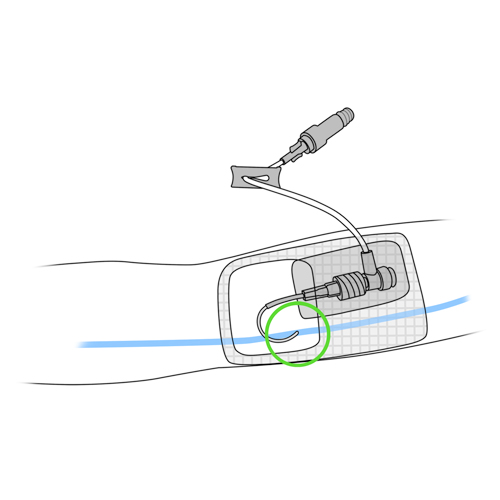
|
Refer to steps 5 through 8 of the Catheter site monitoring procedure.
Why ? This step allows you to quickly detect problems.
|
|
Step 8: Disinfect the needleless connector
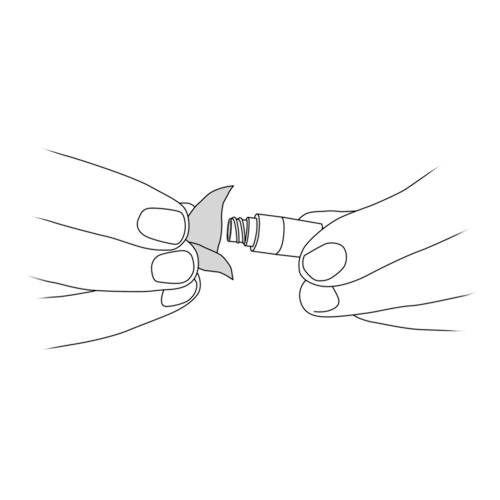
|
- Use a disinfectant swab to vigorously scrub the top and sides of the needleless connector.
- Allow the connector to dry completely by holding it in one hand.
- Do not blow on the connector.
- Do not touch the connector between the time of disinfection and the syringe connection.
Why ? This step is necessary to prevent contamination (transmission of bacteria).
|
|
Step 9: Remove the protective cap from the saline syringe
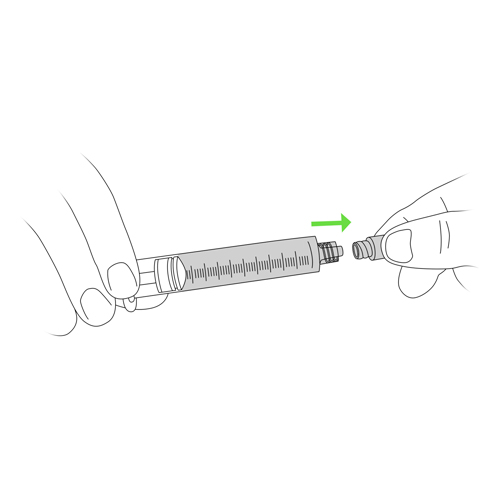
|
- Take the saline syringe with one hand and remove the protective cap with the other.
- Take care that nothing touches the tip of the syringe to avoid contaminating it.
Why ? This step allows the procedure to continue safely.
|
|
Step 10: Screw the syringe onto the needleless connector

|
- Take the needleless connector between the thumb and forefinger of one hand.
- With the other hand, push the syringe into the connector.
- Fasten the syringe by turning it about a quarter turn clockwise until the connection is solid.
- Never use a needle to inject into the needleless connector.
Why ? This step allows the rest of the procedure.
|
|
Step 11: Irrigate the catheter with the saline solution
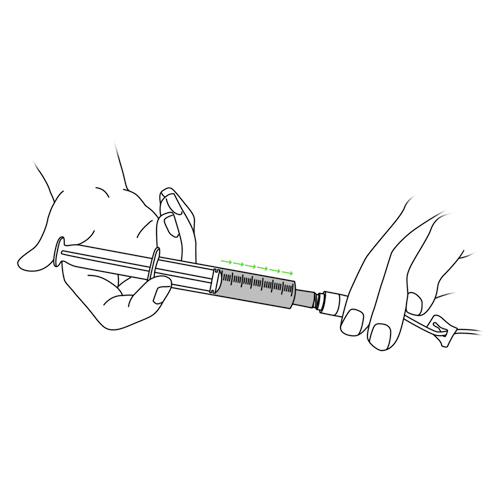
|
- Open the clamp of the catheter tubing.
- Press the plunger of the syringe to inject 1 ml at a time: using a brisk start-stop technique with each ml that is pushed (this helps keep the catheter from getting blocked).
- When the entire solution is injected, close the clamp of the catheter tubing.
Why ? This step removes deposits that accumulate in the catheter and prevents it from blocking.
|
|
Step 12: Disconnect the syringe from the needleless connector
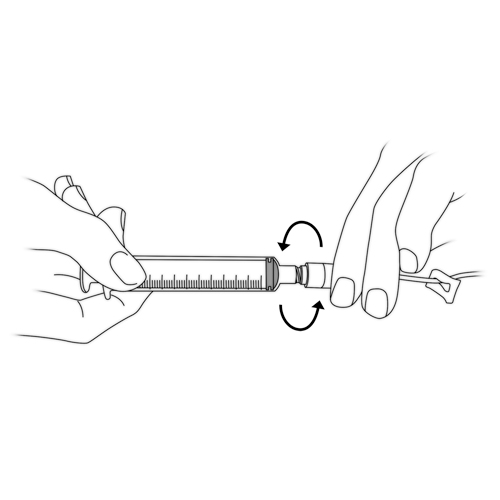
|
- Hold the needleless connector between the thumb and forefinger of one hand.
- With the other hand, disconnect the syringe by turning it counterclockwise.
- Dispose of the syringe in the trash.
Why ? This step allows the rest of the procedure.
Using your two hands prevents the needleless connector from unscrewing instead of the syringe.
|
|
Step 13: Irrigate the catheter with the locking solution, if necessary
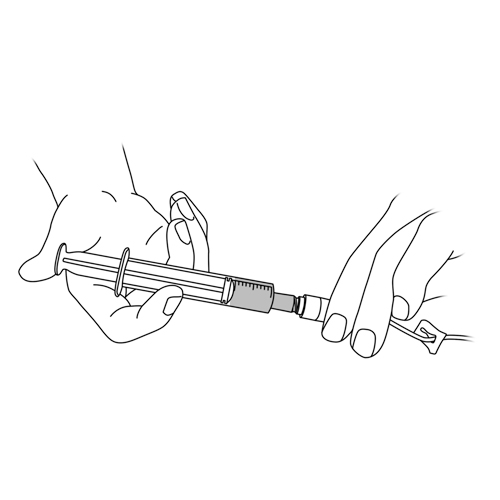
|
Why ? This step prevents the formation of clots at the tip of the catheter when a prolonged delay is expected before its next use.
|
|
Step 14: Monitor the catheter site

|
Refer to steps 5 through 8 of the Catheter site monitoring procedure.
Why ? This step allows you to verify that the catheter site is intact.
|
|
Step 15: Recovery

|
See the full description here
Summary:
The treatment is finished. Wash your hands again.
Be prepared to recognize the challenges faced and to provide positive feedback. Help your child recognize his/her strengths. Acknowledge the collaborative teamwork.
- Listen to what your child says about the parts of the procedure that were difficult or painful.
- Comfort your child and recognize your child’s collaboration with positive feedback.
- Highlight your child’s specific strengths that helped make the procedure positive.
- Discuss with your child what might be done the same or differently the next time the care is needed.
- Keep your promises if you have promised a reward, follow through.
- Reward yourself too.
|
|
![]()